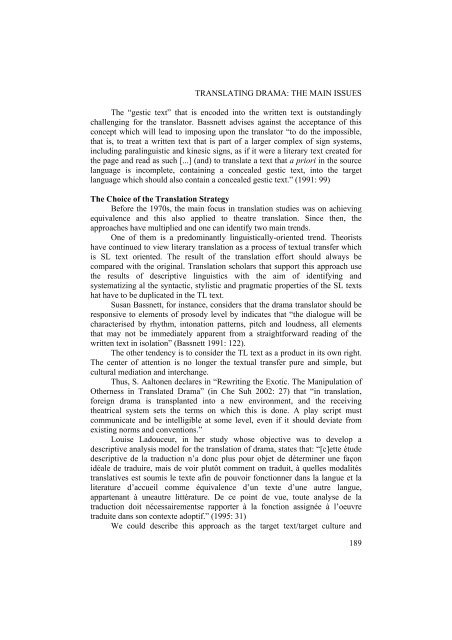culture, subculture and counterculture - Facultatea de Litere
culture, subculture and counterculture - Facultatea de Litere
culture, subculture and counterculture - Facultatea de Litere
You also want an ePaper? Increase the reach of your titles
YUMPU automatically turns print PDFs into web optimized ePapers that Google loves.
TRANSLATING DRAMA: THE MAIN ISSUES<br />
The “gestic text” that is enco<strong>de</strong>d into the written text is outst<strong>and</strong>ingly<br />
challenging for the translator. Bassnett advises against the acceptance of this<br />
concept which will lead to imposing upon the translator “to do the impossible,<br />
that is, to treat a written text that is part of a larger complex of sign systems,<br />
including paralinguistic <strong>and</strong> kinesic signs, as if it were a literary text created for<br />
the page <strong>and</strong> read as such [...] (<strong>and</strong>) to translate a text that a priori in the source<br />
language is incomplete, containing a concealed gestic text, into the target<br />
language which should also contain a concealed gestic text.” (1991: 99)<br />
The Choice of the Translation Strategy<br />
Before the 1970s, the main focus in translation studies was on achieving<br />
equivalence <strong>and</strong> this also applied to theatre translation. Since then, the<br />
approaches have multiplied <strong>and</strong> one can i<strong>de</strong>ntify two main trends.<br />
One of them is a predominantly linguistically-oriented trend. Theorists<br />
have continued to view literary translation as a process of textual transfer which<br />
is SL text oriented. The result of the translation effort should always be<br />
compared with the original. Translation scholars that support this approach use<br />
the results of <strong>de</strong>scriptive linguistics with the aim of i<strong>de</strong>ntifying <strong>and</strong><br />
systematizing al the syntactic, stylistic <strong>and</strong> pragmatic properties of the SL texts<br />
hat have to be duplicated in the TL text.<br />
Susan Bassnett, for instance, consi<strong>de</strong>rs that the drama translator should be<br />
responsive to elements of prosody level by indicates that “the dialogue will be<br />
characterised by rhythm, intonation patterns, pitch <strong>and</strong> loudness, all elements<br />
that may not be immediately apparent from a straightforward reading of the<br />
written text in isolation” (Bassnett 1991: 122).<br />
The other ten<strong>de</strong>ncy is to consi<strong>de</strong>r the TL text as a product in its own right.<br />
The center of attention is no longer the textual transfer pure <strong>and</strong> simple, but<br />
cultural mediation <strong>and</strong> interchange.<br />
Thus, S. Aaltonen <strong>de</strong>clares in “Rewriting the Exotic. The Manipulation of<br />
Otherness in Translated Drama” (in Che Suh 2002: 27) that “in translation,<br />
foreign drama is transplanted into a new environment, <strong>and</strong> the receiving<br />
theatrical system sets the terms on which this is done. A play script must<br />
communicate <strong>and</strong> be intelligible at some level, even if it should <strong>de</strong>viate from<br />
existing norms <strong>and</strong> conventions.”<br />
Louise Ladouceur, in her study whose objective was to <strong>de</strong>velop a<br />
<strong>de</strong>scriptive analysis mo<strong>de</strong>l for the translation of drama, states that: “[c]ette étu<strong>de</strong><br />
<strong>de</strong>scriptive <strong>de</strong> la traduction n’a donc plus pour objet <strong>de</strong> déterminer une façon<br />
idéale <strong>de</strong> traduire, mais <strong>de</strong> voir plutôt comment on traduit, à quelles modalités<br />
translatives est soumis le texte afin <strong>de</strong> pouvoir fonctionner dans la langue et la<br />
literature d’accueil comme équivalence d’un texte d’une autre langue,<br />
appartenant à uneautre littérature. De ce point <strong>de</strong> vue, toute analyse <strong>de</strong> la<br />
traduction doit nécessairementse rapporter à la fonction assignée à l’oeuvre<br />
traduite dans son contexte adoptif.” (1995: 31)<br />
We could <strong>de</strong>scribe this approach as the target text/target <strong>culture</strong> <strong>and</strong><br />
189












